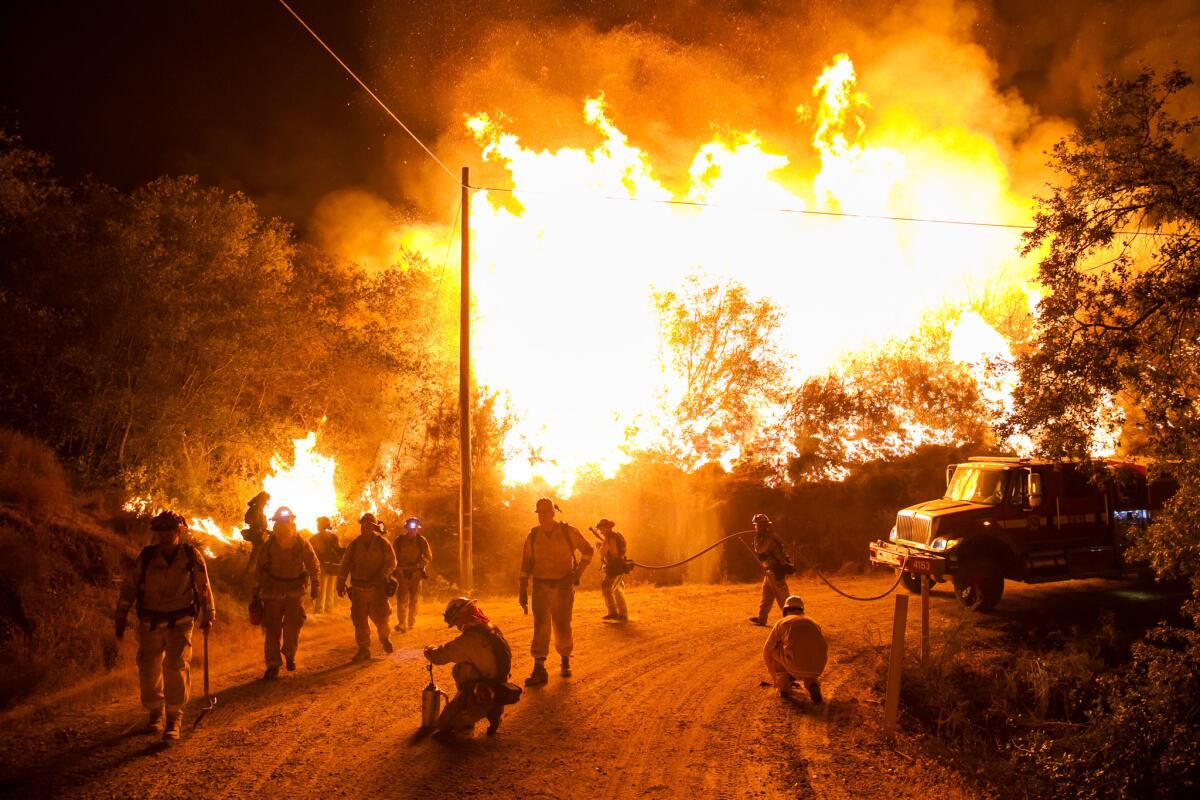Valley fire spread with ‘mind-boggling’ speed, experts say

Firefighters from Tulare work to create a back fire along Fricot City Road to try to contain the growing Butte Fire near Sheep Ranch, Calif.
- Share via
When the Valley fire erupted Saturday afternoon in Lake County, it quickly became clear firefighters weren’t going to be able to keep up.
As officials evacuated homes in its path, the blaze would jump ahead of them, threatening more structures before firefighters could advance.
“Ashes, embers would rain down a quarter-, half-mile behind them,” said Daniel Berlant, a spokesman with the California Department of Forestry and Fire Protection. “As fire crews would make progress -- hold the fire -- it would burn right past them.”
Experts said the Valley fire moved faster than any other in California’s recent past. In less than 12 hours, it had scorched 40,000 acres.
“There aren’t very many fires in California’s history that have done that. I don’t know if there really is a precedent for it,” said Daniel Swain, a climate scientist at Stanford University. “This fire sort of broke the rules even relative to this incredible season that’s already occurred.”
In some ways, the Valley fire is the blaze officials have been worried about all summer: the product of drought conditions made all the more dangerous because it burned through dense terrain dotted by small communities. Although other fires this summer have also spread quickly, this one’s path took it through several rural towns that were left defenseless by its speed and size.
Dry conditions from four years of drought, experts said, were just one factor that made the Valley fire so difficult to fight.
Extremely high temperatures across the state last week, combined with the dried vegetation, allowed the fire to pick up steam in forested areas and then enter towns with a vengeance.
The blaze grew so big that it created its own wind and humidity that mimicked the dangerous effects of Santa Ana winds, shooting out embers that spread the fire.
“It is kind of mind-boggling,” Swain said.
The drought has killed more and more trees each year, making them quick to ignite. An infestation of bark beetles -- which prey on drought-stricken trees -- has also sucked the life from forests across the state.
A U.S. Forest Service survey of the region in and around the Bay Area in June found that tree mortality was increasing almost everywhere.
But the worst region by far, the survey found, was an area south of Clear Lake -- exactly where the Valley fire is burning.
Berlant said triple-digit temperatures last week left the trees “tinder dry.” As those temperatures cooled toward the end of the week, winds picked up, which further fanned the flames, he said.
The fire broke out about 1:30 p.m. Saturday near the community of Cobb, then spread southeast at astonishing speed.
“In some cases, residents only had minutes to evacuate,” Berlant said.
Nicole Young, who lives in the nearby neighborhood of Hidden Valley Lake, said that while she and her parents were discussing how to safely evacuate with their five horses, they saw flames beginning to creep down a hill.
“We have to go now,” Young, 25, remembers thinking. The sky was already dark with smoke. As her family drove out of the community, she saw a market go up in flames. Her father saw a propane tank explode in front of a house.
“The fire was all around us,” she said.
Swain, the Stanford scientist, said the blaze was able to grow enough in forested areas that it turned into a firestorm. Then it pushed into small towns in the region, including Middletown.
The fire released far-reaching embers that allowed it to jump from structure to structure, and beyond typical barriers such as roads and creeks. Hundreds of homes and other structures were lost, including large parts of Middletown’s main street.
Though temperatures dropped and there was even some rain Saturday night, that did nothing to stem the fire’s growth, Berlant said. He said the winds were 20 to 30 mph, but the fire spread as if being fanned by Santa Ana winds, which can blow up to 100 mph. Four firefighters suffered second-degree burns Saturday, he said.
More than a dozen fires are raging across California, including some that began in early July. One, the Rough fire -- which is burning in the Sierra National Forest -- has grown to nearly 130,000 acres and is one of the 20 largest fires in California history, Berlant said.
“The fire behavior this summer is essentially unprecedented,” Swain said. “Unfortunately, that’s very consistent with the climatological picture right now, where we’re seeing a drought of a magnitude that we haven’t seen before.”
soumya.karlamangla@latimes.com
MORE ON CALIFORNIA WILDFIRES:
Middletown suffers a devastating blow
Valley fire: Residents of Middletown tell harrowing survival tales
Raging Valley and Butte fires spur help, sympathy on social media
More to Read
Sign up for Essential California
The most important California stories and recommendations in your inbox every morning.
You may occasionally receive promotional content from the Los Angeles Times.











